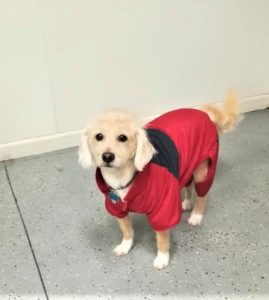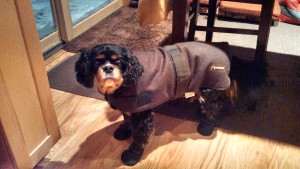 For those of us in the Midwest, the scene replays itself every winter. With winter in full swing check out these tips for keeping your dog in great shape. Grooming is essential even in the winter months!
For those of us in the Midwest, the scene replays itself every winter. With winter in full swing check out these tips for keeping your dog in great shape. Grooming is essential even in the winter months!
Clipping dogs when it’s cold depends on several things; breed, age, comfort, time spent outdoors and most importantly the owners commitment to home maintenance. We are talking about pet dogs with fur that grows continually and normally get clipped during milder weather; setters, spaniels, shih tzu, lhasa apso, poodle etc. and any mixes containing those breeds.
A long or, heavy coated dog, not maintained is worse off than a clipped one in my opinion. Think of a spaniel with long wavy thick fur. Well maintained, this coat is a great asset during the winter months since the spaniels typically love the snow. Keep in mind that all of that fur will be a magnet for ice & snow and may need to be dried and brushed each time the dog comes in. Can this get tedious & time consuming? Yes! Inside the house, that same long thick fur can be so insulating that the dog becomes too warm and will seek cool places to lay. (My own dog, a serious “lap dog”, would not seek out a lap if he was too warm, instead would lay by the back door or on the tile)

“Charlie” ready for winter
If the coat is allowed to grow and is not maintained, it could become matted and snarled , poor protection against the elements and uncomfortable for the dog. Matting is something to avoid at all costs as the only remedy is to shave everything down. Not a great option for winter time no matter what the breed!
For those that insist on a full coated dog in the winter, “no clipping” does not mean “no grooming”. The longer and thicker the fur the more often brushing is required, in some cases, daily. Several of our clients do this and are committed to the daily grooming and the time it requires. A shorter, easy to maintain coat is a better option if your dog is not great with brushing, if you can’t commit the time, or the dog is uncomfortable. If timed correctly , the dog can have it’s longest fur in the coldest months, January & February. This just long enough to get to Spring when the day lengthens and seasonal changes in the coat begin (Shedding!) “Shorter” in this case means somewhere between a full coat and a summer cut on the body and short easy to maintain feet, legs, ears and tail.
Bathing is often avoided during the cold but it too has a place in a dogs regular grooming and hygiene schedule. A good deep cleaning and brushing prior to the coldest of days is important for all breeds, especially the double coated ones! Undercoat has to be maintained to do it’s job as an insulator. Fur is not just window dressing, but along with the skin is a super important organ system. Dry warm air inside and a lack of physical activity can create not so cuddly fur in a short time! Plus, bathing provides a great opportunity to inspect the dog, head to toe, clean ears, faces and rear ends!
A practical suggestion for a dog with a ” winter cut” is to purchase a coat, not for looks but for comfort. A good fitting, breathable, waterproof , wool, or quilted coat or a sweater will be welcomed and most dogs get used to one quickly.
Omega 3 fatty acids are the rock star for skin and coat health especially during harsh winter months. Every dog can benefit from this “healthy fat”. Easy to administer in oil form,Omega 3’s are also anti inflammatory. They can help support heart health as well as ease hip and joint pain. Benefits for the skin and coat are numerous . They can reduce shedding and dander and itchy dry skin. Sardine, salmon, krill, pollock or a combination are available as are fish based foods. Not just for winter, feed these healthy oils year round for optimal health!




